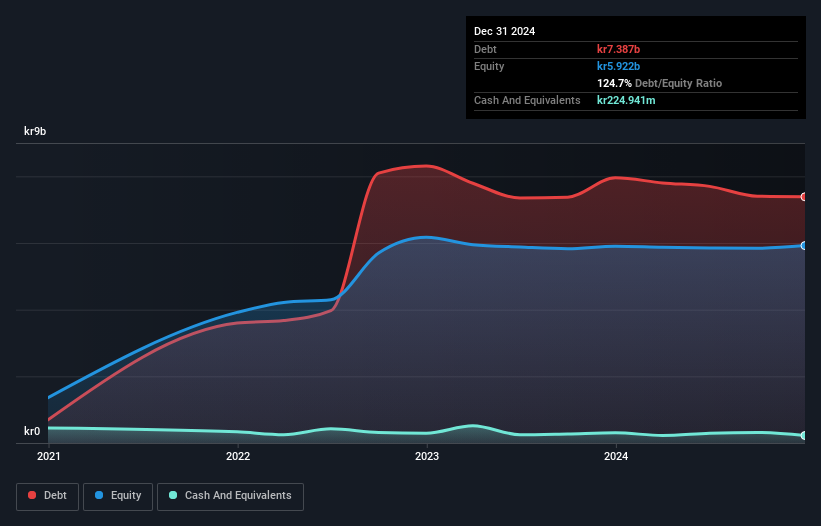- Sweden
- /
- Real Estate
- /
- OM:SFAST
Stenhus Fastigheter i Norden (STO:SFAST) Use Of Debt Could Be Considered Risky
Howard Marks put it nicely when he said that, rather than worrying about share price volatility, 'The possibility of permanent loss is the risk I worry about... and every practical investor I know worries about.' When we think about how risky a company is, we always like to look at its use of debt, since debt overload can lead to ruin. We can see that Stenhus Fastigheter i Norden AB (publ) (STO:SFAST) does use debt in its business. But the more important question is: how much risk is that debt creating?
When Is Debt A Problem?
Debt and other liabilities become risky for a business when it cannot easily fulfill those obligations, either with free cash flow or by raising capital at an attractive price. If things get really bad, the lenders can take control of the business. However, a more usual (but still expensive) situation is where a company must dilute shareholders at a cheap share price simply to get debt under control. Having said that, the most common situation is where a company manages its debt reasonably well - and to its own advantage. When we think about a company's use of debt, we first look at cash and debt together.
What Is Stenhus Fastigheter i Norden's Debt?
As you can see below, Stenhus Fastigheter i Norden had kr7.39b of debt at December 2024, down from kr7.96b a year prior. However, because it has a cash reserve of kr224.9m, its net debt is less, at about kr7.16b.

How Strong Is Stenhus Fastigheter i Norden's Balance Sheet?
The latest balance sheet data shows that Stenhus Fastigheter i Norden had liabilities of kr1.11b due within a year, and liabilities of kr7.05b falling due after that. On the other hand, it had cash of kr224.9m and kr62.4m worth of receivables due within a year. So its liabilities outweigh the sum of its cash and (near-term) receivables by kr7.87b.
The deficiency here weighs heavily on the kr3.28b company itself, as if a child were struggling under the weight of an enormous back-pack full of books, his sports gear, and a trumpet. So we definitely think shareholders need to watch this one closely. At the end of the day, Stenhus Fastigheter i Norden would probably need a major re-capitalization if its creditors were to demand repayment.
Check out our latest analysis for Stenhus Fastigheter i Norden
We use two main ratios to inform us about debt levels relative to earnings. The first is net debt divided by earnings before interest, tax, depreciation, and amortization (EBITDA), while the second is how many times its earnings before interest and tax (EBIT) covers its interest expense (or its interest cover, for short). Thus we consider debt relative to earnings both with and without depreciation and amortization expenses.
Stenhus Fastigheter i Norden shareholders face the double whammy of a high net debt to EBITDA ratio (10.0), and fairly weak interest coverage, since EBIT is just 1.8 times the interest expense. The debt burden here is substantial. Notably, Stenhus Fastigheter i Norden's EBIT was pretty flat over the last year, which isn't ideal given the debt load. There's no doubt that we learn most about debt from the balance sheet. But ultimately the future profitability of the business will decide if Stenhus Fastigheter i Norden can strengthen its balance sheet over time. So if you want to see what the professionals think, you might find this free report on analyst profit forecasts to be interesting.
Finally, while the tax-man may adore accounting profits, lenders only accept cold hard cash. So we always check how much of that EBIT is translated into free cash flow. In the last three years, Stenhus Fastigheter i Norden's free cash flow amounted to 46% of its EBIT, less than we'd expect. That's not great, when it comes to paying down debt.
Our View
To be frank both Stenhus Fastigheter i Norden's net debt to EBITDA and its track record of staying on top of its total liabilities make us rather uncomfortable with its debt levels. But at least its conversion of EBIT to free cash flow is not so bad. We're quite clear that we consider Stenhus Fastigheter i Norden to be really rather risky, as a result of its balance sheet health. So we're almost as wary of this stock as a hungry kitten is about falling into its owner's fish pond: once bitten, twice shy, as they say. When analysing debt levels, the balance sheet is the obvious place to start. However, not all investment risk resides within the balance sheet - far from it. For example Stenhus Fastigheter i Norden has 4 warning signs (and 2 which make us uncomfortable) we think you should know about.
If you're interested in investing in businesses that can grow profits without the burden of debt, then check out this free list of growing businesses that have net cash on the balance sheet.
New: Manage All Your Stock Portfolios in One Place
We've created the ultimate portfolio companion for stock investors, and it's free.
• Connect an unlimited number of Portfolios and see your total in one currency
• Be alerted to new Warning Signs or Risks via email or mobile
• Track the Fair Value of your stocks
Have feedback on this article? Concerned about the content? Get in touch with us directly. Alternatively, email editorial-team (at) simplywallst.com.
This article by Simply Wall St is general in nature. We provide commentary based on historical data and analyst forecasts only using an unbiased methodology and our articles are not intended to be financial advice. It does not constitute a recommendation to buy or sell any stock, and does not take account of your objectives, or your financial situation. We aim to bring you long-term focused analysis driven by fundamental data. Note that our analysis may not factor in the latest price-sensitive company announcements or qualitative material. Simply Wall St has no position in any stocks mentioned.
About OM:SFAST
Stenhus Fastigheter i Norden
A real estate company, owns and manages public and commercial properties in the Greater Stockholm region of Sweden.
Second-rate dividend payer with low risk.
Market Insights
Community Narratives


Recently Updated Narratives


Engineered for Stability. Positioned for Growth.


MINISO's fair value is projected at 26.69 with an anticipated PE ratio shift of 20x


Fiverr International will transform the freelance industry with AI-powered growth
Popular Narratives


MicroVision will explode future revenue by 380.37% with a vision towards success


NVDA: Expanding AI Demand Will Drive Major Data Center Investments Through 2026



